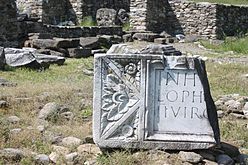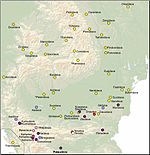- Ulpia Traiana Sarmizegetusa
-
For the former Dacian capital, see Sarmizegetusa Regia. For the modern-day commune, see Sarmizegetusa (commune).
 Ulpia Traiana Sarmizegetusa
Ulpia Traiana Sarmizegetusa
The frontispiece of Forum
In honorem domus divinae L(ucius) Ophonius Pap(iria) Domitius Priscus IIvir col(oniae) Dacic(ae) pecunia sua fecit l(ocus) d(atus) d(ecreto) d(ecurionum)Founded during the reign of Trajan Founded 2nd century AD Place in the Roman world Roman province Dacia Structure — Stone structure — Size and area 600 m x 540 m (32.4 ha) Shape Round rectangle — Wood and earth [1] structure — Stationed military units — Legions — - IV Flavia Felix [1]
- vexill. XIII Gemina
Location Coordinates 45°30′47″N 22°47′14″E / 45.5130°N 22.7873°E Town Sarmizegetusa County Hunedoara Country  Romania
RomaniaSite notes Condition Ruined Colonia Ulpia Traiana Augusta Dacica Sarmizegetusa was the capital and the largest city of Roman Dacia, later named Ulpia Traiana Sarmizegetusa after the former Dacian capital, located some 40 km away. Built on the ground of a camp of the Fifth Macedonian Legion, the city was populated with veterans of the Dacian wars. It received from the very beginning the title of colonia and the status of Ius Italicum. With an area of 30 ha and a population between 20.000 - 25.000 and strong fortifications, Ulpia Traiana was the political, administrative and religious centre of Dacia Romana, in the 2nd and 3rd centuries.
The city was destroyed by the Goths. Today Ulpia Traiana remains in ruins, with a partly conserved forum, an amphitheatre, and remnants of several temples.
Contents
History
The exact period when the city was built is not known. Some say the first settlement was erected between 106-107, other say it was between 108-110. However, due to an inscription discovered at the beginning of the 14th century in the village of Gradiste, it is known that the settlement of the new town was done in the first years after the conquest of Dacia. The inscription reads: "On the command of the emperor Cesar Nerva Traianus Augustus, son of the divine Nerva, was settled the Dacian Colony by Decimus Terentius Scaurianus, its governor."
In Rome, the settlement of the colony was marked by the minting of a coin, at the Senate's order, dedicated to emperor Trajan.
During the reign of Hadrian the city was renamed Colonia Ulpia Traiana Augusta Dacica Sarmizegetusa. Between 222 - 235 the colony is called metropolis. The name was found on a stone inscription that reads "To Caius Arrius Quadratus, son of Gaius Arrius Antoninus, acting praetor of the emperor in colonia Ulpia Traiana Augusta Dacica Sarmizegetusa." Gaius Arrius Antoninus bore the title legatus pro praetore, which was the official title of the governor of some imperial provinces of the Roman Empire.
Location
The settlement was built at a distance of 8 km from Tapae, a pass between Banat and Transylvania (today known as The Iron Gates of Transylvania). The choice was based on the military and economic advantages given by the natural barrier represented by the Retezat Mountains in the South and Poiana Ruscă Mountains in the North. The territory of the metropolis laid from Tibiscum to Micia and to the Jiu canyon, the city being protected by several castra: Tibiscum, Voislova, Micia şi Bumbeşti.
The city was crossed by the imperial road from Danube that marked the linked between the North of the province and Porolissum (Moigrad).
Archeological Site
Today, the archeological site contains:
- Amphitheatre
- Gladiator School
- Goddess Nemesis Temple
- Liber Pater Temple
- Gods Aesculap and Hygia Temple
- Temple Basilica
- Big Temple
- God Silvanus Temple
- Glass Blowers Workshops
- Horreum
- Financial procurator's Office
- Thermae
- Forum
Virtual Reconstructions
These are the reconstructions published by Reconstituiri.ro:
Image gallery
See also
Notes
External links
- (English) ULPIA TRAIANA SARMIZEGETUSA
- (Romanian) ULPIA TRAIANA SARMIZEGETUSA
Ancient Dacian cities and/or fortresses Acidava • Acmonia • Aedava • Aiadava • Aizis • Amutria • Apulon • Arcina • Arcobadara • Argedava • Argidava (Arcidava) • Arutela • Berzobis • Bregedava • Brucla • Buricodava • Buridava • Buteridava • Capidava • Carsidava • Clepidava • Cumidava • Danedevae • Dausdava • Desudaba • Diacum • Dierna • Dinogetia • Docidava • Drobeta • Egeta • Gatae • Genucla • Germisara • Gildava • Giridava • Itadava • Keiladeva • Klepidaua • Kuimedaba • Malva (Romula) • Marcodava • Murideva • Napoca • Nentidava • Oescus • Patridava • Patruissa • Pelendava • Perburidava • Petrodava • Pinon • Piroboridava • Polondava • Potaissa • Pulpudeva • Quemedava • Ramidava • Ratiaria • Recidava • Romboses • Rusidava • Sacidava • Sagadava • Sandava • Sangidaua • Sarmizegetusa Regia • Scaidava • Setidava • Singidava • Sucidava • Sucidava, Moesia • Susudava • Sykidaba • Tamasidava • Tapae • Thermidava • Tibiscum • Tirista • Tsierna • Tyrida • Ulpia Traiana Sarmizegetusa • Utidava • Zaldapa • Zargidava • Zeugma • Zicideva • Zimnicea • Ziridava • Zisnudeva • Zucidaua • Zurobara • Zusidava
Cities/fortresses with unknown names: Ardan • Ardeu • Arpașu de Sus • Breaza • Bretea Mureșană • Băile Tușnad • Bănița • Bâzdâna • Cernat • Cetățeni • Cotnari • Covasna • Crăsanii de Jos • Crizbav • Cuciulata • Cugir • Cârlomănești • Căpâlna • Drajna de Sus • Jigodin • Mala Kopania • Marca • Merești • Moșna • Odorheiu Secuiesc • Olteni • Orăștie Mountains • Polovragi • Porumbenii Mari • Praid • Racu • Satu Mare (Harghita) • Sprâncenata • Stâncești • Sânzieni • Șeica Mică • Tășad • Teliu • Tilișca • Timișu de Jos • Turia • Valea Seacă • Zemplín Dacia Maps on Commons • Dacian fortresses, settlements and Roman castra from Romania: Google Maps • Google EarthCategories:
Dacia Maps on Commons • Dacian fortresses, settlements and Roman castra from Romania: Google Maps • Google EarthCategories:- Archaeological sites in Romania
- Dacia
- Former populated places in Romania
- Roman Dacia
- Roman towns and cities in Romania
Wikimedia Foundation. 2010.











